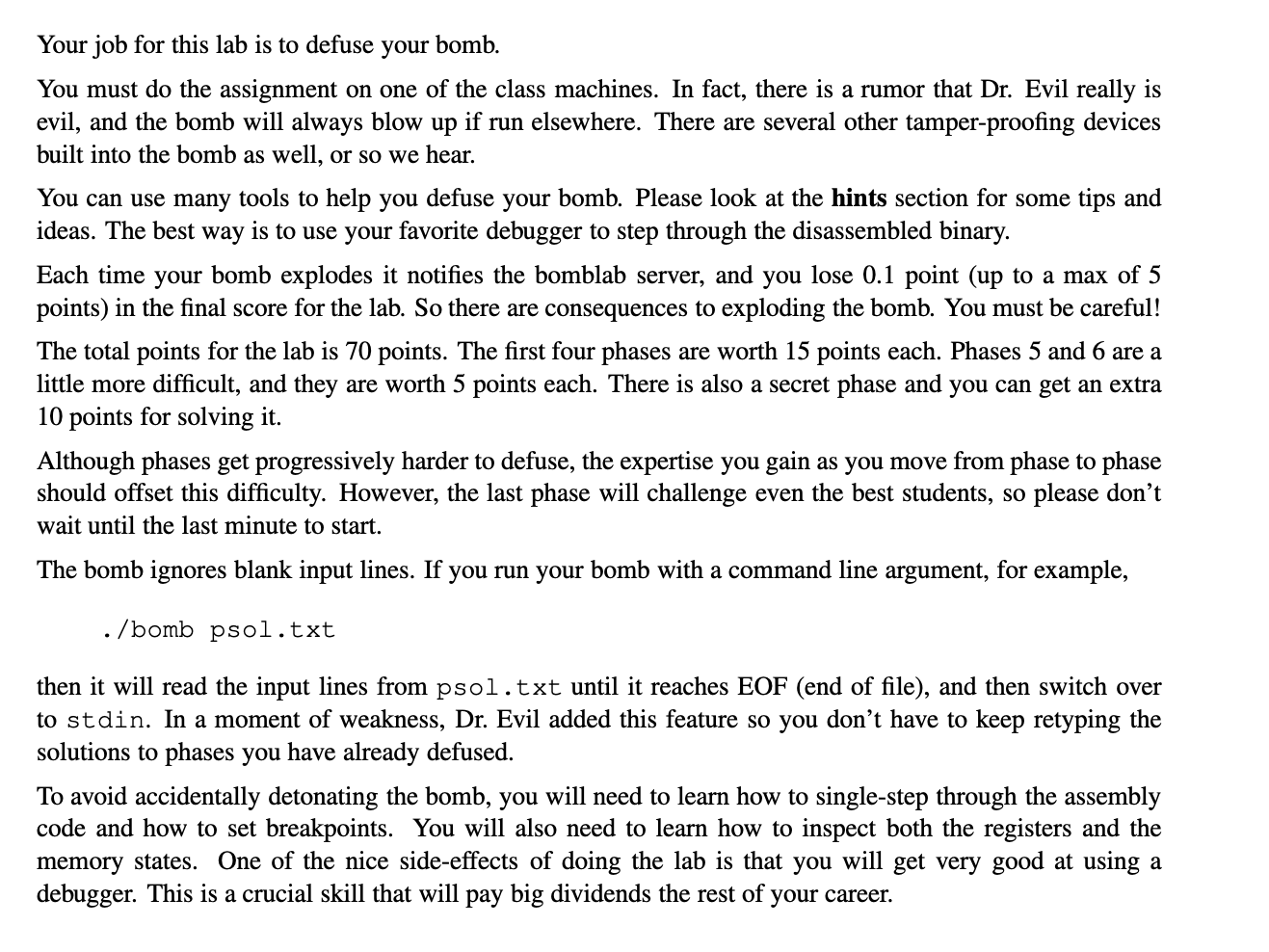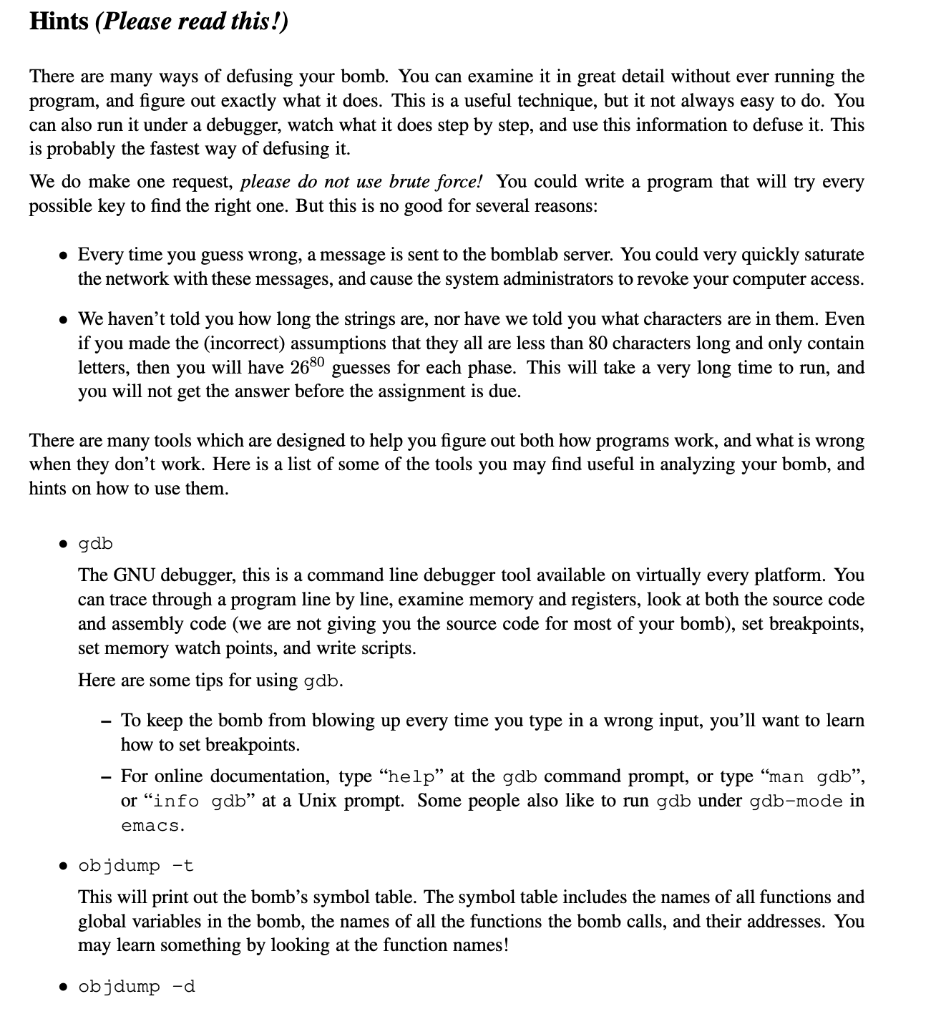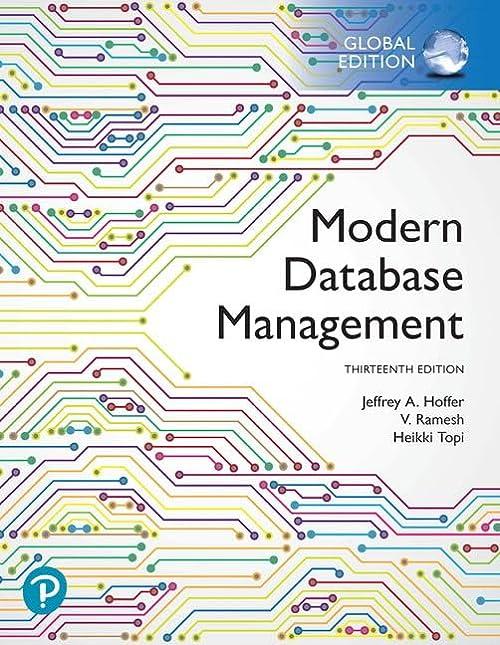Question
Instructions: You must fill the C programming code in the following format below: #include #include #include support.h #include phases.h /* * Note to self: Remember
Instructions:



You must fill the C programming code in the following format below:
#include
/* * Note to self: Remember to erase this file so my victims will have no * idea what is going on, and so they will all blow up in a * spectaculary fiendish explosion. -- Dr. Evil */
FILE *infile;
int main(int argc, char *argv[]) { char *input;
/* Note to self: remember to port this bomb to Windows and put a * fantastic GUI on it. */
/* When run with no arguments, the bomb reads its input lines * from standard input. */ if (argc == 1) { infile = stdin; }
/* When run with one argument
/* You can't call the bomb with more than 1 command line argument. */ else { printf("Usage: %s [
/* Do all sorts of secret stuff that makes the bomb harder to defuse. */ initialize_bomb();
printf("Welcome to my fiendish little bomb. You have 6 phases with "); printf("which to blow yourself up. Have a nice day! ");
/* Round and 'round in memory we go, where we stop, the bomb blows! */ input = read_line(); phase_5(input); phase_defused(); printf("Good work! On to the next... ");
return 0; }
Your job for this lab is to defuse your bomb. You must do the assignment on one of the class machines. In fact, there is a rumor that Dr. Evil really is evil, and the bomb will always blow up if run elsewhere. There are several other tamper-proofing devices built into the bomb as well, or so we hear. You can use many tools to help you defuse your bomb. Please look at the hints section for some tips and ideas. The best way is to use your favorite debugger to step through the disassembled binary. Each time your bomb explodes it notifies the bomblab server, and you lose 0.1 point (up to a max of 5 points) in the final score for the lab. So there are consequences to exploding the bomb. You must be careful! The total points for the lab is 70 points. The first four phases are worth 15 points each. Phases 5 and 6 are a little more difficult, and they are worth 5 points each. There is also a secret phase and you can get an extra 10 points for solving it. Although phases get progressively harder to defuse, the expertise you gain as you move from phase to phase should offset this difficulty. However, the last phase will challenge even the best students, so please don't wait until the last minute to start. The bomb ignores blank input lines. If you run your bomb with a command line argument, for example, ./bomb psol.txt then it will read the input lines from psol.txt until it reaches EOF (end of file), and then switch over to stdin. In a moment of weakness, Dr. Evil added this feature so you don't have to keep retyping the solutions to phases you have already defused. To avoid accidentally detonating the bomb, you will need to learn how to single-step through the assembly code and how to set breakpoints. You will also need to learn how to inspect both the registers and the memory states. One of the nice side-effects of doing the lab is that you will get very good at using a debugger. This is a crucial skill that will pay big dividends the rest of your career. Hints (Please read this!) There are many ways of defusing your bomb. You can examine it in great detail without ever running the program, and figure out exactly what it does. This is a useful technique, but it not always easy to do. You can also run it under a debugger, watch what it does step by step, and use this information to defuse it. This is probably the fastest way of defusing it. We do make one request, please do not use brute force! You could write a program that will try every possible key to find the right one. But this is no good for several reasons: - Every time you guess wrong, a message is sent to the bomblab server. You could very quickly saturate the network with these messages, and cause the system administrators to revoke your computer access. - We haven't told you how long the strings are, nor have we told you what characters are in them. Even if you made the (incorrect) assumptions that they all are less than 80 characters long and only contain letters, then you will have 2680 guesses for each phase. This will take a very long time to run, and you will not get the answer before the assignment is due. There are many tools which are designed to help you figure out both how programs work, and what is wrong when they don't work. Here is a list of some of the tools you may find useful in analyzing your bomb, and hints on how to use them. - gdb The GNU debugger, this is a command line debugger tool available on virtually every platform. You can trace through a program line by line, examine memory and registers, look at both the source code and assembly code (we are not giving you the source code for most of your bomb), set breakpoints, set memory watch points, and write scripts. Here are some tips for using gdb. - To keep the bomb from blowing up every time you type in a wrong input, you'll want to learn how to set breakpoints. - For online documentation, type "help" at the gdb command prompt, or type "man gdb", or "info gdb" at a Unix prompt. Some people also like to run gdb under gdb-mode in emacs. - objdump -t This will print out the bomb's symbol table. The symbol table includes the names of all functions and global variables in the bomb, the names of all the functions the bomb calls, and their addresses. You may learn something by looking at the function names! - objdump -d Use this to disassemble all of the code in the bomb. You can also just look at individual functions. Reading the assembler code can tell you how the bomb works. Although objdump - d gives you a lot of information, it doesn't tell you the whole story. Calls to system-level functions are displayed in a cryptic form. For example, a call to sscanf might appear as: \[ \text { 8048c36: e8 } 99 \text { fc ff ff call 80488d4 } \] To determine that the call was to sscanf, you would need to disassemble within gdb. - strings This utility will display the printable strings in your bomb. Looking for a particular tool? How about documentation? Don't forget, the commands apropos, man, and info are your friends. In particular, man ascii might come in useful. info gas will give you more than you ever wanted to know about the GNU Assembler. Also, the web may also be a treasure trove of information. If you get stumped, feel free to ask your instructor for helpStep by Step Solution
There are 3 Steps involved in it
Step: 1

Get Instant Access to Expert-Tailored Solutions
See step-by-step solutions with expert insights and AI powered tools for academic success
Step: 2

Step: 3

Ace Your Homework with AI
Get the answers you need in no time with our AI-driven, step-by-step assistance
Get Started


